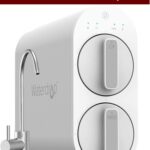Water softener can cause blue stains because it can add metal ions to the water.
Water softeners are often used in homes to combat hard water. Hard water is water that contains a high concentration of minerals, such as calcium and magnesium. These minerals can cause a variety of problems in the home, such as making it difficult to clean dishes or clothing. A water softener works by exchanging the minerals in hard water for sodium ions. This process is known as ion exchange.
While a water softener can be an effective way to combat hard water, it can also cause blue stains. This is because the sodium ions that are exchanged for the minerals in hard water can cause a blue deposit to form on surfaces that come into contact with the water. This can be particularly evident on light-colored surfaces, such as white laundry. If you have a water softener and you notice blue stains on your laundry, you may need to adjust the settings on the softener or use a different laundry detergent.
How Can Water Softener Cause Blue Stains On Laundry?
The blue stains are caused by the laundry detergent not fully rinsing out of the clothing.
Install a Home Water Filter & Get "Unlimited Safe Drinking Water" For Decades
Get Upto 55% Discount With a Lifetime Warranty & 6-Months Money Back Guarantee Free Shipping
SpringWell Water Filtration Systems: 100% American-Made & NSF Certified Water Filters and Water Softeners

Have you ever pulled your laundry out of the washing machine, only to find it covered in blue stains?
If so, your water softener may be to blame.
Water softeners work by removing minerals from hard water, such as calcium and magnesium. These minerals can build up in your washing machine and cause blue stains on your laundry.
To remove blue stains from your laundry, you’ll need to clean your washing machine. Start by running a cycle with hot water and vinegar. This will help to remove any mineral build-up in your machine.
If your washing machine doesn’t have a hot water setting, you can fill it with hot water from the tap. Just be sure to add the vinegar to the water before adding your laundry.
Once you’ve run a cycle with hot water and vinegar, you can run another cycle with just hot water. This will help to rinse any remaining vinegar from your machine.
If you have hard water, you may need to clean your washing machine more often to prevent blue stains on your laundry. However, by following these simple steps, you can keep your laundry looking great.
How Can Water Softener Cause Blue Stains In Toilets?
Water softener can cause blue stains in toilets because the blue dye can leach into the water and cause staining.
If your toilet is suddenly stained blue, it’s likely that your water softener is to blame. While water softeners are great for reducing hard water buildup in your home, they can sometimes cause blue stains in toilets. Here’s a look at how water softeners can cause blue stains in toilets and what you can do to prevent them.
Hard water contains high levels of minerals, including magnesium and calcium. These minerals can cause a variety of problems in your home, from reducing the efficiency of your appliances to making it difficult to get soap suds to form when you’re washing your hands. Water softeners work by exchanging the minerals in hard water for sodium ions. This process helps to reduce the build-up of minerals in your home and prevents the problems that hard water can cause.
However, the sodium in water softeners can sometimes cause blue stains in toilets. This is because the blue dye in many toilet bowl cleaners reacts with the sodium to create a blue stain. The good news is that these stains are usually easy to remove. Simply use a toilet brush and some toilet bowl cleaner to scrub away the stain.
If you’re concerned about the possibility of blue stains in your toilet, you can take some steps to prevent them. First, be sure to use a toilet bowl cleaner that doesn’t contain blue dye. Second, don’t use as much water softener as you typically would. This will help to reduce the amount of sodium in your water, which will in turn reduce the likelihood of blue stains. Finally, be sure to brush your toilet regularly to remove any build-up of minerals that could lead to staining.
By following these tips, you can help to prevent blue stains in your toilet from water softeners.
FAQ
How Can Water Softener Cause Blue Stains In Sinks?
How Can Water Softener Cause Blue Stains In Shower Stalls?
Conclusion
The blue stains that can be caused by water softeners are the result of the high concentration of minerals in the water. These minerals can react with the chemicals in the water to create the blue stains.
If you have any questions about how water softeners can cause blue stains, feel free to leave a comment below.


